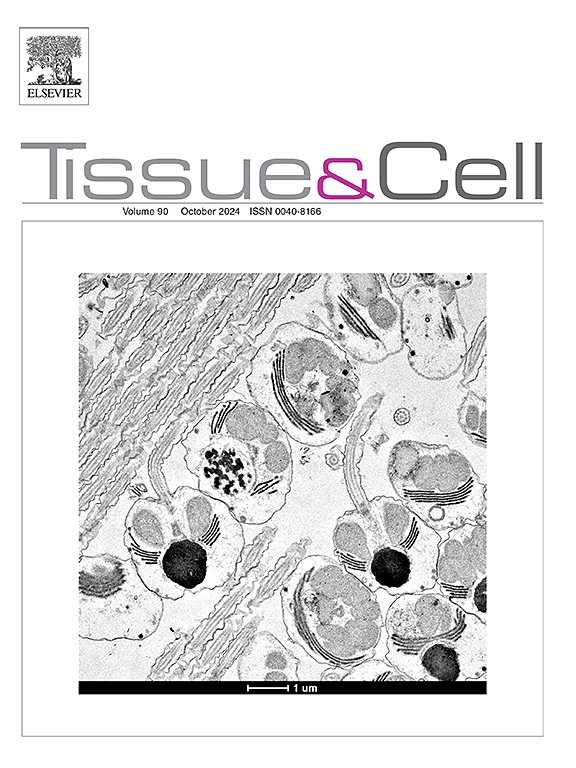The role of misoprostol in the prevention of amikacin-induced neuronal damage
IF 2.7
4区 生物学
Q1 ANATOMY & MORPHOLOGY
引用次数: 0
Abstract
Amikacin (AK) is an aminoglycoside widely used in the treatment of Gram-negative infections which are life-threatening. In the etiology of toxicity, AK has been shown to cause tissue damage through oxidative stress and apoptosis as a consequence of the reactive oxygen species (ROS) production. Misoprostol (MP) is a prostaglangin E1 (PGE1) analogue with antioxidant, antiapoptotic, cytoprotective properties used to prevent gastrointestinal disorders induced by nonsteroidal anti-inflammatory drug. This study aims to investigate the neuroprotective effects of MP on brain cells against the neurotoxicity of AK by gene expression and histopathological analyses. Twenty-four male Spraque-Dawley rats were randomly separated into four groups (group 1, control; group 2, AK; group 3, MP; group 4, AK + MP). According to our findings, AK treatment significantly increased brain weight, brain weight/body weight ratios, and CYP2B1 mRNA gene expression. This was accompanied by histopathological changes such as eosinophilic neurons, pyknotic nuclei, vacuolated neuropil, congestion and inflammation in blood vessels. On the other hand, while significant improvements were observed in brain weight and brain weight/body weight ratios in the AK + MP group, there was a significant decrease in CYP2B1 mRNA gene expression levels and histopathological changes. According to our results, MP may serve as a potential therapeutic candidate to reduce the severity of oxidative damage induced by AK in brain tissue.
米索前列醇在预防阿米卡星诱导的神经元损伤中的作用
阿米卡星(AK)是一种氨基糖苷,广泛用于治疗危及生命的革兰氏阴性感染。在毒性的病因学中,AK已被证明通过氧化应激和细胞凋亡引起组织损伤,这是活性氧(ROS)产生的结果。米索前列醇(Misoprostol, MP)是一种前列腺素E1 (PGE1)类似物,具有抗氧化、抗凋亡和细胞保护作用,用于预防非甾体抗炎药引起的胃肠道疾病。本研究旨在通过基因表达和组织病理学分析,探讨MP对脑组织抗AK神经毒性的保护作用。雄性Spraque-Dawley大鼠24只,随机分为4组(1组,对照组;第二组,AK;第3组,MP;第4组,AK + MP)。根据我们的研究结果,AK治疗显著增加了脑重、脑重/体重比和CYP2B1 mRNA基因表达。同时伴有嗜酸性神经元、核固缩、神经细胞空泡化、血管充血和炎症等组织学改变。另一方面,AK + MP组在脑重和脑重/体重比显著改善的同时,CYP2B1 mRNA基因表达水平和组织病理学改变显著降低。根据我们的研究结果,MP可能作为一种潜在的治疗候选者,以减轻AK在脑组织中引起的氧化损伤的严重程度。
本文章由计算机程序翻译,如有差异,请以英文原文为准。
求助全文
约1分钟内获得全文
求助全文
来源期刊

Tissue & cell
医学-解剖学与形态学
CiteScore
3.90
自引率
0.00%
发文量
234
期刊介绍:
Tissue and Cell is devoted to original research on the organization of cells, subcellular and extracellular components at all levels, including the grouping and interrelations of cells in tissues and organs. The journal encourages submission of ultrastructural studies that provide novel insights into structure, function and physiology of cells and tissues, in health and disease. Bioengineering and stem cells studies focused on the description of morphological and/or histological data are also welcomed.
Studies investigating the effect of compounds and/or substances on structure of cells and tissues are generally outside the scope of this journal. For consideration, studies should contain a clear rationale on the use of (a) given substance(s), have a compelling morphological and structural focus and present novel incremental findings from previous literature.
 求助内容:
求助内容: 应助结果提醒方式:
应助结果提醒方式:


